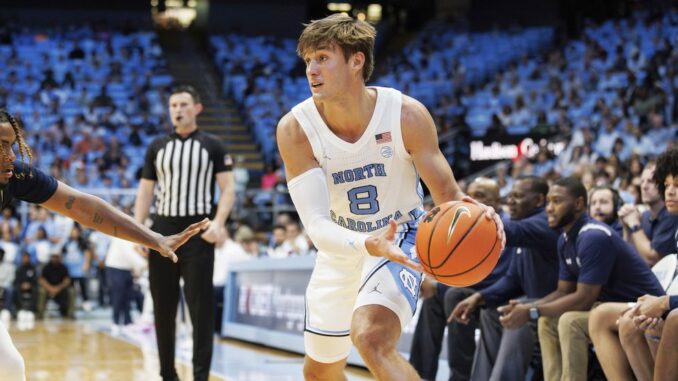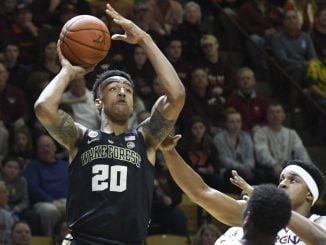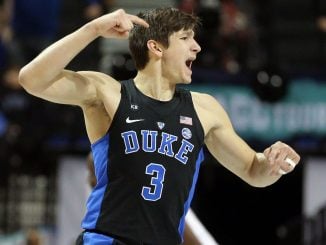
Paxson Wojcik made history in his first few seconds as a North Carolina Tar Heel. The transfer from Brown got the start in UNC’s season opener, and as the ball was tipped off, Wojcik became the first Tar Heels player to wear jersey No. 8 in more than 70 years.
For the record, Dick Patterson was the last Carolina player to wear 8, back in 1951, two years before the birth of the ACC. When Seth Trimble came off the bench about 10 minutes in, he became the first Heel to wear No. 7 since Simon Terrell in 1950.
“Eight’s always been my lucky number,” Wojcik, who wore 0 with Brown last year, explained. “I was born 8/8, August 8th.”
Good news for Cancers, Leos and Virgos — for the first time in seven decades, college basketball players can wear digits greater than 5 on their uniforms. The NCAA decided to change one of the oddest rules in sports over the offseason despite the fact that there was not much of an outcry to do so. Yet here we are, with a new look for this college basketball season.
The rule in question can be found in the official NCAA officiating rulebook at rule 1, section 22, article 7, clause b.2. It read, “The following numbers are legal: 0, 1, 2, 3, 4, 5, 00, 10, 11, 12, 13, 14, 15, 20, 21, 22, 23, 24, 25, 30, 31, 32, 33, 34, 35, 40, 41, 42, 43, 44, 45, 50, 51, 52, 53, 54, and 55. Team rosters can include 0 or 00, but not both.”
That’s a long-winded way of saying that no digits greater than 5 can be used, in either the tens place or the ones place on a college jersey. The reasoning was that referees needed to be able to signal fouls to the scorer’s table, using one hand for each digit on the jersey.
The original rule was the solution to something that wasn’t really that big of a problem. The NBA has always allowed numbers over 5 on jerseys.
George Mikan wore 99 in the late 1940s. Bill Russell wore 6 in the ’60s, and Dr. J wore 6 in the ’70s. Dennis Rodman wore 91 in the ’90s. More recently, Kobe Bryant (8) and LeBron James (6) have worn numbers that would be illegal in college. Referees never seemed to struggle to identify any of them when they committed fouls.
The new digits are part of an overall loosening of uniform restrictions. Teams can now get more creative with the layout of logos and text as they come up with new jersey designs. Players no longer need special permission to wear religious headgear during games. And rule 1-22-7-b-2 has gotten edited down.
“The following numbers are legal: 0-99,” it now reads. “Team rosters can include 0 or 00, but not both.”
There has not exactly been a run on the newly legal numbers. In fact, the change seems to have been met with a collective shrug by college players. Including Trimble and Wojcik, a total of 43 players from teams in power conferences will be wearing previously illegal numbers this season. Among ACC teams from the state, only UNC opted to take any old numbers out of mothballs. Duke, Wake Forest and NC State remain old school, perhaps looking to gain favor with ACC referees by making their lives easier.
USC’s Bronny James, wearing the 6 jersey his dad donned in Miami, is probably the biggest name to take advantage of the new rule. Of the 43 power conference players wearing numbers with 6, 7, 8 or 9, 39 players opted for single digit numbers: 7 was the most popular, with 12 players choosing it. The least popular single-digit number was 6, with just a half-dozen players wearing it.
Only four players put the new numbers into double-digit jersey numbers: Xavier’s Lazar Djokovic (17) and UCLA’s Jan Vide (27) both freshmen, Arizona’s Keshad Johnson (16), a transfer who wore 0 with San Diego State, and Missouri’s Connor Vanover, the only power conference player to choose a number greater than the previous maximum, 55. Vanover will wear 75 this year.
Among non-power conference teams in the state, roughly half have players taking advantage of the rule change. Eight — App State, Elon, Davidson, UNC Asheville, NC Central, Western Carolina, UNC Wilmington and UNC Greensboro — are only using digits 0-5. The other seven teams have a combined 16 players with new digits. East Carolina, Queens, High Point and Gardner-Webb have three each.
Just like the power conferences across the nation, in-state players prefer single digits to double, with 15 of the 18 (including Wojcik and Trimble) choosing one-digit numbers. Seven is again the most popular, with six players in North Carolina wearing it. High Point’s Liam Carney will wear 16, as will NC A&T’s Nikolaos Chitikoudis. Charlotte’s Iaroslav Niagu will wear the largest number in college basketball this season, No. 99.
International players and transfers are the most likely to test out the new rule, the former perhaps unfamiliar with the jersey number restrictions in the first place and the latter looking to make a new start.
“It’s the first year we can do it, and it’s my last year,” Wojcik said. “So I said, ‘Why not?’”



